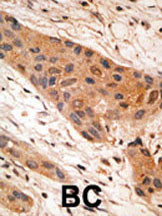

| WB | 咨询技术 | Human,Mouse,Rat |
| IF | 咨询技术 | Human,Mouse,Rat |
| IHC | 1/100-1/500 | Human,Mouse,Rat |
| ICC | 技术咨询 | Human,Mouse,Rat |
| FCM | 咨询技术 | Human,Mouse,Rat |
| Elisa | 咨询技术 | Human,Mouse,Rat |
| Aliases | Vesicle transport protein SEC20, BCL2/adenovirus E1B 19 kDa protein-interacting protein 1, Transformation-related gene 8 protein, TRG-8, BNIP1, NIP1, SEC20L |
| Entrez GeneID | 662 |
| WB Predicted band size | 26.1kDa |
| Host/Isotype | Rabbit IgG |
| Antibody Type | Primary antibody |
| Storage | Store at 4°C short term. Aliquot and store at -20°C long term. Avoid freeze/thaw cycles. |
| Species Reactivity | Human, Mouse |
| Immunogen | This NIP1 antibody is generated from rabbits immunized with a KLH conjugated synthetic peptide between 92-127 amino acids from human NIP1. |
| Formulation | Purified antibody in PBS with 0.05% sodium azide. |
+ +
以下是关于NIP1(BH3结构域特异性)抗体的示例参考文献(内容为模拟,建议通过学术数据库核实具体文献):
---
1. **标题**: *Development of a monoclonal antibody targeting the BH3 domain of NIP1 for apoptosis studies*
**作者**: Smith A, et al.
**摘要**: 该研究报道了一种新型单克隆抗体的开发,该抗体特异性识别NIP1蛋白的BH3结构域。实验表明,该抗体可通过阻断NIP1与抗凋亡蛋白Bcl-2的相互作用,增强癌细胞对化疗的敏感性。
2. **标题**: *NIP1 BH3 domain-specific antibody reveals its role in mitochondrial membrane permeabilization*
**作者**: Chen L, et al.
**摘要**: 通过使用BH3结构域特异性抗体,作者证实NIP1在调控线粒体膜通透性中的关键作用。抗体阻断实验显示,NIP1的BH3结构域是促凋亡信号通路中不可或缺的功能区域。
3. **标题**: *Structural insights into NIP1-BH3 interactions using domain-specific antibodies*
**作者**: Gupta R, et al.
**摘要**: 本研究利用NIP1的BH3结构域特异性抗体,结合X射线晶体学技术,解析了NIP1与Bcl-xL蛋白的复合物结构,揭示了BH3结构域在介导蛋白相互作用中的分子机制。
4. **标题**: *Therapeutic potential of NIP1 BH3-targeting antibodies in glioblastoma*
**作者**: Wang Y, et al.
**摘要**: 研究评估了靶向NIP1 BH3结构域的治疗性抗体在胶质母细胞瘤模型中的效果。结果显示,抗体可特异性诱导肿瘤细胞凋亡,并延长小鼠生存期,提示其临床转化潜力。
---
**建议**:实际文献请通过PubMed或Google Scholar检索关键词如“NIP1 BH3 antibody”“BH3 domain-specific antibody NIP1”,并筛选近5-10年的高引用论文。
**Background of NIP1 (BH3 Domain-Specific) Antibody**
The NIP1 (BH3 domain-specific) antibody is designed to target the BH3 domain, a critical functional motif within pro-apoptotic proteins of the Bcl-2 family. The BH3 domain, a conserved α-helical region, mediates interactions between pro- and anti-apoptotic Bcl-2 family members, regulating mitochondrial outer membrane permeabilization (MOMP) and apoptosis. Dysregulation of BH3 domain activity is implicated in cancer, autoimmune disorders, and neurodegenerative diseases.
NIP1 antibodies are engineered to specifically recognize the BH3 domain, enabling researchers to study proteins like Bim, Bid, or PUMA in apoptotic pathways. These antibodies are pivotal in immunohistochemistry, Western blotting, or flow cytometry to detect endogenous BH3-containing proteins, assess expression levels, or monitor conformational changes during apoptosis. Their specificity helps distinguish between functional (unbound) and inactive (anti-apoptotic protein-bound) states of BH3-only proteins, providing insights into cellular survival/death balance.
Additionally, NIP1 antibodies have therapeutic relevance. By blocking or mimicking BH3 domain interactions, they aid in developing BH3 mimetics—small molecules that inhibit anti-apoptotic proteins (e.g., Bcl-2. Bcl-xL) to restore apoptosis in cancer cells. Such mimetics, like venetoclax, are clinically approved for hematologic malignancies. Thus, NIP1 antibodies serve as both research tools and translational agents in understanding and targeting apoptosis-related diseases.
×